Qana
If you followed the EastSouthWestNorth blog from inception, you will know that this was an anti-war blog founded after the invasion of Iraq. But that was a long time ago, and I have pretty much lost my sense of rage. I had no nuanced and subtle views beyond that which is summarized in the simple statement of Scout Tufankjian in Slate: A Photographer in Gaza.
My politics are pretty simple. Killing people is bad. Killing civilians is worse. Killing children is an obscenity.
I believe that most people share that view and that is why the most popular in the history of the EastSouthWestNorth blog is The Children of Iraq.
I have no interest in getting into the byzantine arguments about the Israel-Lebanon-Hizbollah issue. There are others who are infinitely more knowledgeable about it. But as I said, my views are simple: Killing children is an obscenity, so let me show you some photos from Qana, Lebanon. Here I don't mean the Red Cross ambulance that had apparently been targeted by a precision weapon because certain partisans say that this photo was faked. Hey, what do I know anyway?
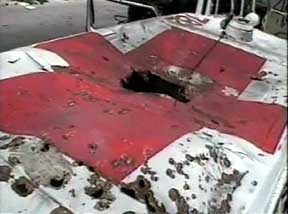
Here, I want to present to you the series of photos from Qana. What happened in Qana? Here is Reuters:
Police said Qana, about 11 km (seven miles) from the border with Israel, was bombed at 1:30 a.m. (2230 GMT on Saturday). The raid flattened a three-storey building where about 63 displaced people were in the basement. Many were killed as they slept. "Why have they attacked one- and two-year-old children and defenseless women?" asked one bereaved man, Mohamed Samai. The bodies were wrapped tightly in plastic sheets and assembled under an awning. Flowers were placed on the corpses. ...
In Qana, rescue workers lay a girl's body on the ground and ran to search for more. They heaved hunks of concrete off a dead child crushed underneath. The rigid corpse of a young boy, his bloody face disfigured, lay near a pulverized building. Hours later, rescuers were still clambering over rubble using their hands to extract corpses. Two mechanical diggers, one provided by U.N. peacekeepers, eventually joined the effort.
Now for the photos:
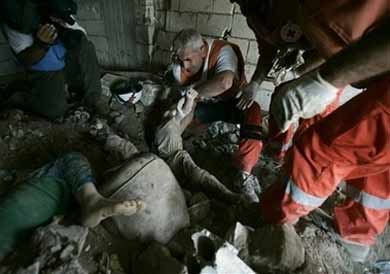
(AP Photo/Nasser Nasser)
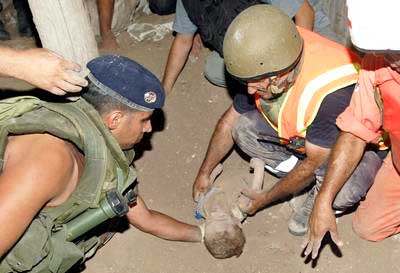
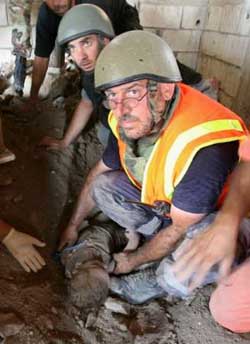
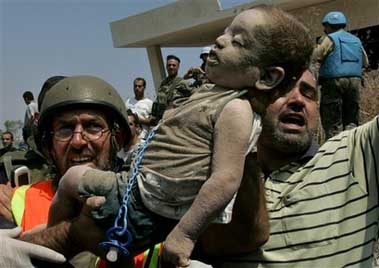
(AP Photo/Kevin Frayer)
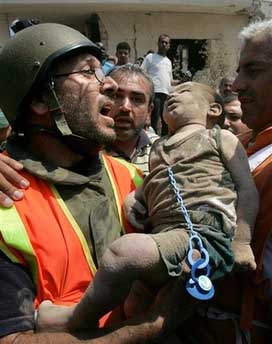
(AP Photo/Kevin Frayer)
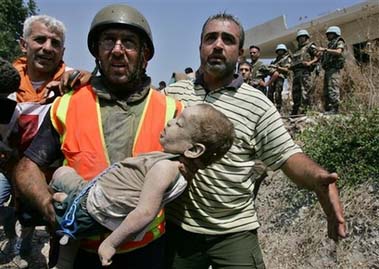
(AP Photo/Kevin Frayer)
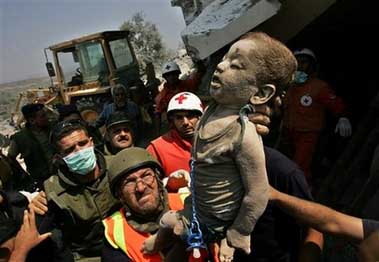
(AP Photo/Kevin Frayer)
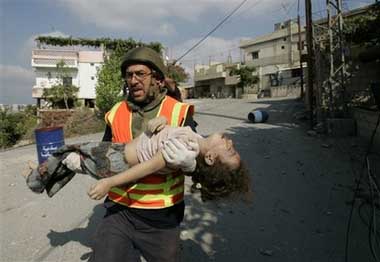
(AP Photo/Nasser Nasser)
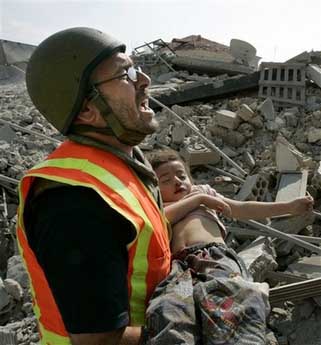
(AP Photo/Nasser Nasser)
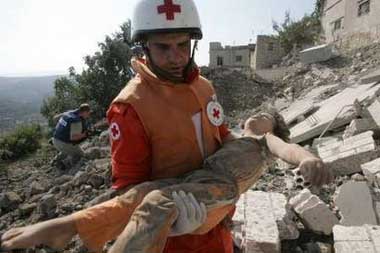
(Reuters/Zohra Bensemra)
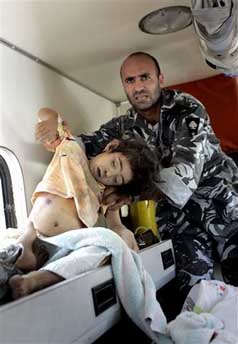
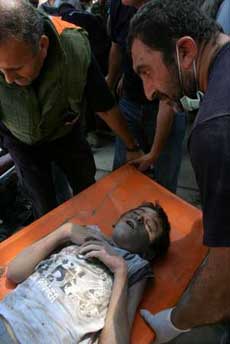
(Reuters/Ali Hashisho)
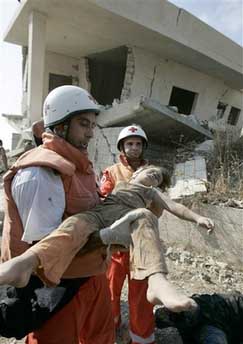
(AP Photo/Nasser Nasser)
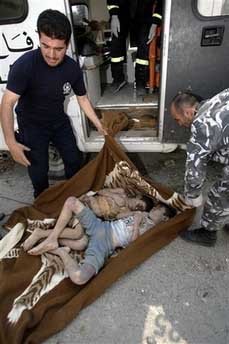
(AP Photo/Lefteris Pitarakis)
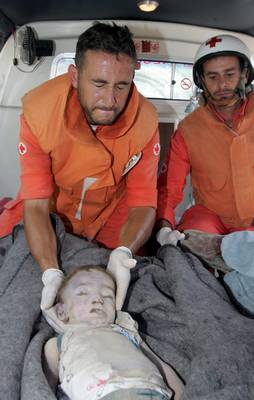
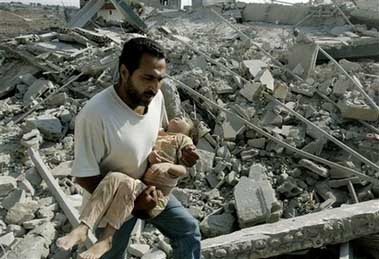
(AP Photo/Nasser Nasser)
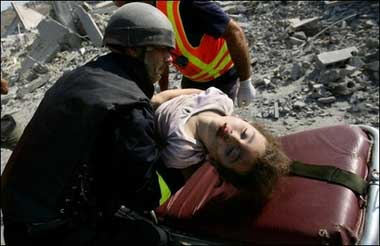
(AFP/Nicolas Asfouri)
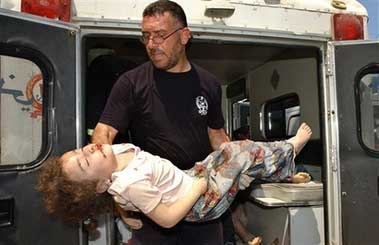
(AP Photo/Mohammed Zaatari)
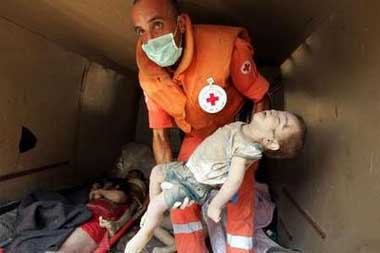
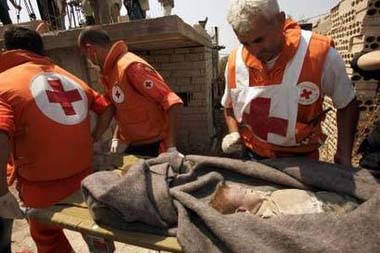
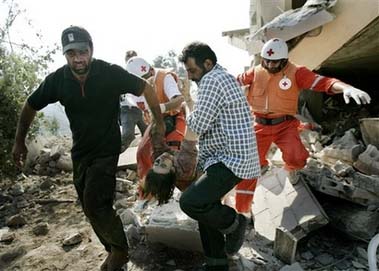
(AP Photo/Nasser Nasser)
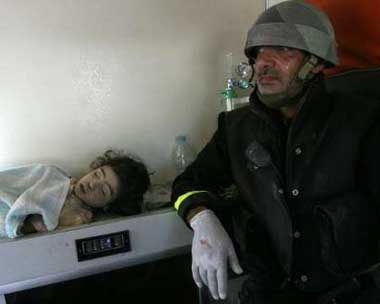
(Reuters/Ali Hashisho)
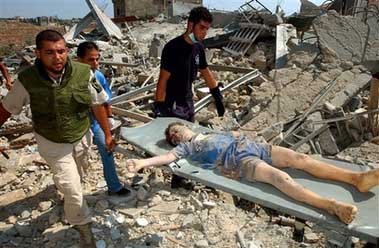
(AP Photo/Mohammed Zaatari)
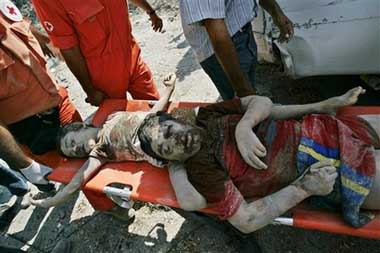
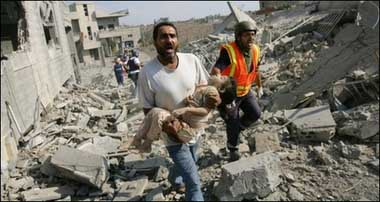
(AFP/File/Nicolas Asfouri)
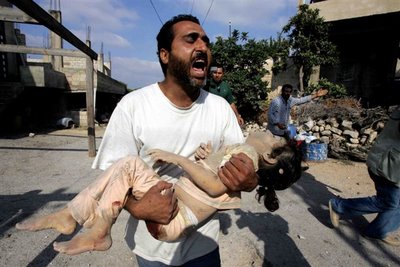
(Reuters/Zohra Bensemra)
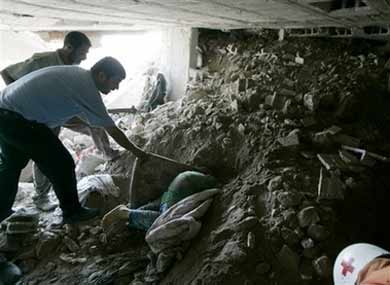
(AP Photo/Nasser Nasser)
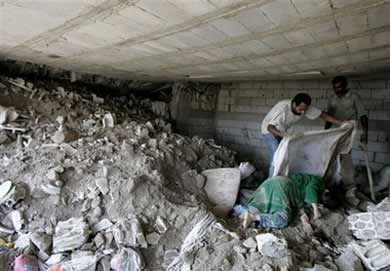
(AP Photo/Nasser Nasser)
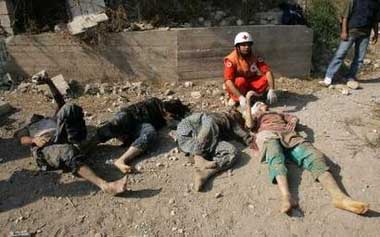
(Reuters/Zohra Bensemra)
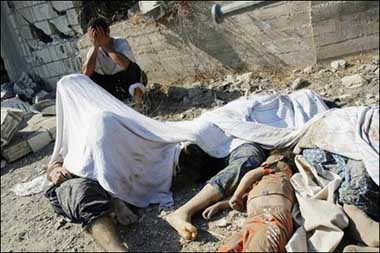
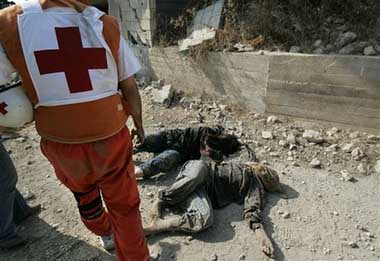
(AP Photo/Nasser Nasser)
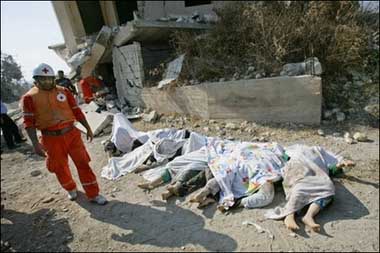
(AP Photo/Lefteris Pitarakis)
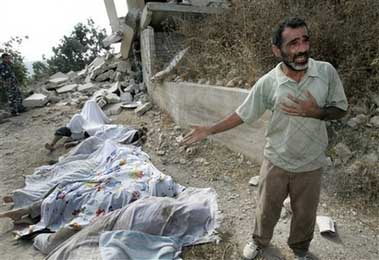
(AP Photo/Lefteris Pitarakis)
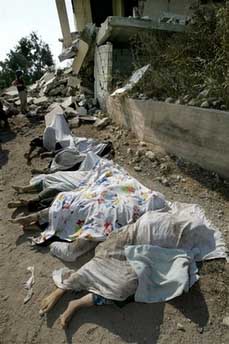
(AP Photo/Lefteris Pitarakis)
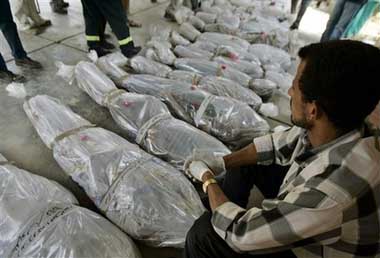
(AP Photo/Nasser Nasser)
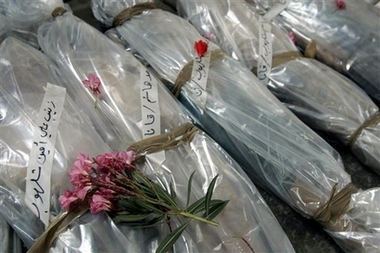
(AP Photo/Nasser Nasser)
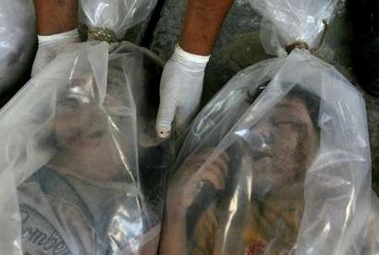
(Reuters/Ali Hashisho)
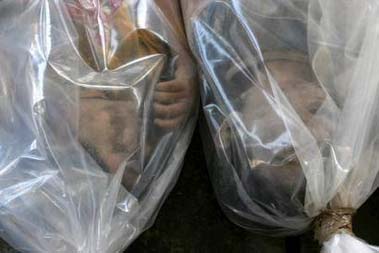
(REUTERS/Ali Hashisho)
According to some pundits, the Israeli foray into Lebanon was intended to persuade the people to turn against Hizbollah. Here is a public opinion poll after the invasion (via Billmon):
The stakes are high for Hizbullah, but it seems it can count on an unprecedented swell of public support that cuts across sectarian lines. According to a poll released by the Beirut Center for Research and Information, 87 percent of Lebanese support Hizbullah's fight with Israel, a rise of 29 percent on a similar poll conducted in February. More striking, however, is the level of support for Hizbullah's resistance from non-Shiite communities. Eighty percent of Christians polled supported Hizbullah along with 80 percent of Druze and 89 percent of Sunnis. Lebanese no longer blame Hizbullah for sparking the war by kidnapping the Israeli soldiers, but Israel and the US instead.
This is not working out, is it? But that is wandering astray. Israel has the right to defend itself when attacked, but is what the photos show the proper response? And so what if the Lebanese government told US Secretary of State Condi Rice to stay away in the aftermath? I am just simple and naÔve, and I only know:
My politics are pretty simple. Killing people is bad. Killing civilians is worse. Killing children is an obscenity.
Yes, I'm just a bleeding heart liberal ...
(Daily Star) Qana relives 1996 massacre as air strike kills at least 60 civilians. By Nicholas Blanford. July 31, 2006.
"Where is the humanity? Why are these massacres being committed against civilians?" asked Naim Raqa, the head of the Lebanese Civil Defense unit in the nearby village of Jawaya, who was assisting in the rescue operation.
There were dozens of people drawn from two extended families sleeping on the ground floor of an unfinished house when an Israeli jet dropped two bombs on them, destroying most of the building and crushing at least 60 victims under rubble and dirt. Only eight people managed to survive the massive double blast and haul themselves from beneath the debris.
It was the bloodiest moment so far in Israel's 19-day onslaught against Lebanon.
The half-finished three-story house belonged to Abbas Hashem and lay at the end of a
narrow lane that winds down a hillside flanked by olive groves and small tobacco patches.
The Hashem family and their close neighbors, the Shalhoubs, had moved onto the ground floor 10 days earlier, hoping that a large pile of dirt and sand for construction would help protect them from the heavy artillery bombardments and repeated air strikes in and around Qana.
Although most residents of this village of some 12,000 people had already fled to Tyre, 10 kilometers to the west, or headed further north, the Shalhoub and Hashem families had found themselves cut off.
"We couldn't get out of our neighborhood because there are only two roads leading out and the Israelis bombed them both several days ago," said Mohammad Shalhoub, a disabled 41-year-old who was recovering in Tyre's government hospital.
Both families were asleep when the two bombs dropped hit the building in rapid succession at 1 a.m.
"I felt the blast throw me across the room. I was buried under the rubble along with the martyrs," Mohammad said.
Mohammad's wife, Rabab, hauled him clear of the debris and rescued their son, Hassan, 4, but his daughter Zeinab, 6, was left dead under the rubble. He also lost his sister, Fatmeh, and brother, Tayseer.
Further air strikes and heavy artillery bombardments during the night - which destroyed at least four other houses in the neighborhood - meant that it was another six hours before the rescue services could reach the stricken village.
The Hashem house leaned at a perilous angle, threatening to collapse at any moment, as Civil Defense workers climbed gingerly into the building to recover the dead. Two soldiers used spades to carefully dig away at a pile of dirt under which most of the victims were buried.
A kitten mewed as it scampered over the ruins of its dead owner's home. On a patch of land beside the house, tobacco leaves threaded on wires dried to a wrinkled brown in the sun. Beside the partially demolished house was a deep crater, a familiar sight in South Lebanon, where hundreds of buildings have been flattened by powerful aerial bombs.
Throughout the morning under a blazing sun, sweating rescue workers removed bodies from the house. Most of them were children under 12, all coated in gray dust, some with mouths, eyes and ears clogged with dirt. They showed little signs of injury, however, despite having been sleeping just meters from where the bombs struck."They suffocated under the dirt," said Sami Yazbek, head of Tyre's Lebanese Red Cross unit.
Kamil Sleiman, 35, and Ibrahim Skayki, 38, from the neighboring villages of Ain Baal and Biyada, said they heard the news on television and had come to help. They squatted against a stone wall for a cigarette break, their arms smeared with sweat and dust.
"We lost seven people in Ain Baal," Skayki said, adding that his carpentry business was destroyed in the first of many air raids on the village since the war began on July 12. "I lost my work and I had debts to pay, but it's a sacrifice for the resistance."
An earth-mover ground down the lane and began clawing chunks of concrete away from the building. Even as the rescue team toiled to recover the dead, Israeli jets continued to roar overhead and the thump of air strikes and exploding artillery shells reverberated around the steep valley.
Amid the despair and the grim task of removing the victims, there was deep anger at what they regarded as the callous indifference of the West to their suffering. "We will never wave the white flag. We won't retreat," said Mohammad Shalhoub. "I say to the West, this is not the kind of freedom and democracy we want."
Mohammad's phone rang constantly as friends and family asked about him and his relatives. One woman, her voice tinny but audible over the cellphone's loudspeaker, introduced herself as a friend of Tayseer.
"I am his brother," Mohammad told her.
"How is he?" she asked.
"May God have mercy on him," he replied gently.
The woman began to sob, moaning: "no, no."
Another phone call and Shalhoub reeled off a list of names of people who died or survived. "Najwa was injured, Zeinab was martyred," he said. On mentioning the name of Zeinab, his daughter, he choked up and began weeping while a woman placed a comforting arm across his shoulder.
In a neighboring bed lay Noor Hashem, 13, a niece of Abbas Hashem, in whose house she was sheltering. In a shy tremulous voice, Noor said her mother pulled her free from the rubble along with her older sister, Zeinab, and took them to a neighboring house. Her mother returned to try and find Noor's three brothers.
"They haven't come to the hospital yet and my mother hasn't returned," she said, and began crying.
Her three brothers are dead, the youngest only 10 months old, but no one at the hospital had the heart to break the news to Noor.
In April 1996, during another attempt by Israel to crush Hizbullah, more than 100 civilians were killed when Israeli artillery shells struck the headquarters of the Fijian UN peacekeeping battalion in Qana, just five minutes' walk from the Hashem house. The international outcry over that first Qana massacre forced Washington to begin urgently negotiating a cease-fire agreement to halt the bloodshed.
But even as Israeli troops mounted a new incursion into Lebanon faced stiff resistance from Hizbullah fighters, residents of this tragic village feared the worst.
"When Israel is feeling weakened," said Ghazi Idibi, 38, a neighbor of Abbas Hashem, "it commits bigger and bigger massacres."
(Washington Post) A Refuge That Became a Place of Death. By Anthony Shadid. July 31, 2006.
The bulldozer slowly clawed at the rubble Sunday, in motions gentle for a machine. In its path were what was left of life: a bag of onions and a can of beans, a dirt-crusted sandal, a baby bottle, a plaid bag with a diaper still tucked inside and a punctured picture of a young boy, posing awkwardly, his arms stiff at his side. As the sun arced overhead, Israeli shelling thundering in the distance, the shouts went out: "Stop! Stop!" Rescuers surged, then one emerged, his back slightly stooped.
Cradled in his arms was the 27th victim pulled from a partially buried room that had sheltered 63 people in the southern Lebanese village of Qana. The victim's name was Abbas Hashem, and he was 1 year old. His blue pacifier still dangled from his green tank top.Behind the pair was a book, tossed by the blast into a splintered olive tree.
"The Keys to Heaven," its title read.
Tragedy visited Qana again Sunday, a once-picturesque village of figs, grapevines and olive trees along rolling, rocky hills where Lebanese believe Jesus Christ turned water into wine for a wedding. It was here on April 18, 1996, that 106 people were killed when Israeli forces shelled a U.N. compound that had given refuge to 800 Lebanese. The Lebanese government said that at least 57 people were killed in an Israeli attack on the same village Sunday, 37 of them children, their bodies frozen in the angles that only death can bring.
Most of the 27 people whose bodies were recovered had suffocated, choking to death on dirt and debris as their refuge became their cemetery.
"The people thought they were safe in a shelter," Bassam Muqdad, the head of a Lebanese Red Cross team, said simply.
Israel said its attack on the three-story, concrete and cinder-block building, perched atop a ridge along a winding dirt road, came after rockets were fired from the area. Villagers were blunt in their support for Hezbollah but insisted that fighters were not operating near their homes. They said the village had been under Israeli surveillance for a week, their movements in and out of the shelter clearly visible. The village itself, they said, is under the control of Amal, a Shiite Muslim group and sometime rival of Hezbollah.
The scene was desperate Sunday, filled with anger at the loss of civilian life, a sense of abandonment, incomprehension, defiance and grief.
"I'm staying here! I'm dying in my village!" an elderly man shouted as rescue workers tried to get him to leave Qana.
He was one of the last left. Finally, he was pushed to the village's edge.
Soon after, a stretcher passed, carrying a corpse."Hassan! My cousin! Hassan!" a man shouted as he clambered, crying, toward the body.
The building itself had buckled, as if it had been lifted and set back down at chaotic angles. Chunks of concrete dangled from twisted iron rods. A pillow and mattress were sandwiched between dirt, stone and metal. Inside the dimly lit room, soldiers, Red Cross workers and volunteers dug with hoes, shovels and their bare hands, at times frantically, tossing chunks of concrete to the side. Metal poles and pieces of lumber from the house were propped under a sagging roof, forcing rescue workers to bend low as they dug."Be careful!" an officer shouted. "Slowly! Gently!"
A bulldozer moved back and forth. In its way was a knot of children's clothes, strewn along the road outside the shelter. Back and forth it went, grinding them further into the dirt. Along a wall lay the artifacts of lost lives: a red bag inscribed "Sportswear," a child's gray shorts, a pink towel, a tin teakettle, a red cup and a radio with its battery compartment open. Propped over them was a floral-patterned blue mattress with two fresh bloodstains the size of grapefruits. Flies converged on them.
The bulldozer dragged more items into the open: a yellow sponge still in its wrapper and a broken white plate.
Then more bodies came out, all from two extended families, the Hashems and Shalhoubs, who had sought shelter in the building for a week or more. The arm of one person was extended, as if calling for help. Another man appeared to have died as he was putting on his pants to flee. Twelve-year-old Hussein Hashem was removed, curled in a fetal position, his mouth covered in dirt. He was rushed to an ambulance, the jostling making him look lifelike. A Red Cross worker put a stethoscope to his chest, more as a formality than anything.
Then Abbas Hashem, the baby, emerged, his frail body held above the crowd. A purple bruise covered his forehead, his tongue hung out. He was coated in dust. At one point, a rescue worker gingerly wiped the dirt off his cheek.
"All the bodies that we've found choked on the dirt," said Muqdad, the Red Cross team leader.
He watched the rescue effort as it dragged on into the evening. His voice was soft, but frustrated and angry.
"There's a house over there," Muqdad said, pointing in the distance. "There's dead, and we can't get to them."
"These are all civilians," he added. "There's no base here, this isn't a military area. There's nothing around here."
Virtually everything in Qana was coated in a film of gray dust. Drying tobacco swayed in a breeze, tethered to tree branches. Olive trees, perhaps a century old, were split like toothpicks. Stretches of the village around the Imam Ali Mosque were reduced to rubble, wires dangling along the street. A car had been hurled into a grove, a brown Persian rug hanging out of what used to be its roof. A donkey brayed, and a cat wandered through wreckage."The child who choked to death, what was his sin?" asked Khalil Burji, a 54-year-old electrician watching the recovery, who counted two friends among the dead. "When you see something like this, what can you feel?"
Burji said the two extended families had sought shelter in the newly built house, judging it safer than their older, sometimes shoddily built homes. The ground floor was built against a hill, and the valley below seemed to provide a buffer. But the shelling that night was as intense as any the villagers had seen in the fighting. At 1 a.m., as the children tried to sleep and the adults brewed tea, the first bomb struck outside the shelter, where a fragment inscribed MK-84 remained the next day.Ibrahim Shalhoub, a tobacco farmer, and his cousin, Mohammed, fled to the town square to seek help. By the time they returned, between five and 15 minutes later, a second bomb struck the shelter, burying those inside.
"I got dizzy, then I passed out, and I don't what happened next," said Najwa Zeinab, 35, who was pulled out of the rubble by Shalhoub, but lost her brother, Tayseer, her sister, Nabila, and her 6-year-old niece.
Screams and cries pierced the night, with shouts suffocated by the thunder of explosions. "Don't die! Don't die!" Zeinab Shalhoub remembered people yelling inside as they lay buried or pinned by rubble, choking on dirt and smoke. Others called for their fathers and their brothers. "Ali!" "Mohammed!" Mothers were trapped with their children, sometimes listening as they took their last breaths.
"I knew they were all going to die," Ibrahim Shalhoub said.
Shalhoub called the civil defense and the Lebanese Red Cross for help. But the roads were too dangerous. When Red Cross workers tried to make it at 6:30 a.m., they were forced to turn back three times because of Israeli shelling, Muqdad said.
"We tried, but the bombs were falling right in front of us," he said.
By afternoon, some of the 27 bodies were laid out on plastic along the cement floor of a courtyard at Tyre's government hospital. Mehdi Hashem was 7. Hussein Hashem was 12. Abbas Hashem was 1. Ali Shalhoub was a child, but no one knew his age. None of his family had survived. The children were wrapped in blankets, sheets or bedspreads, then sheathed in plastic. Each end was taped, and their names were written by hand with a black marker on another piece of tape strapped around their waists. They were loaded into a refrigerated truck, the cool interior of the temporary morgue creating a mist when its doors were opened.
"No one should have to see this," said Mohammed Tahmaz, a 28-year-old resident watching bodies being loaded.
At the hospital, people grappled with the decision to tell survivors their relatives had died.
"There are families that have no one left, not one child," said Zeinab Shalhoub, who lost her father, Ahmed; mother, Affaf; sister, Awla; brother, Ali; and another brother, Yusuf. "My sweetheart," she said after mentioning each of their names.
In the hospital's courtyard, Mohammed Shalhoub sat with lifeless eyes, his right hand broken. His wife, Khadija, and his mother, Hasna, were dead, as were his daughters Hawra and Zahra, ages 12 and 2. So were his sons, Ali, 10, Yahya, 9, and Assem, 7.
For long moments, he was quiet. Then he spoke, to no one in particular.
"I wish God would have left me just one child," he said softly.
He started crying, his body heaving. "Oh, God!" he yelled.
(Democracy Now!) July 31, 2006.
AMY GOODMAN: Following Israelís bombing of the town of Qana, that killed nearly 57 people, we turn to veteran war correspondent, Robert Fisk. I reached Robert Fisk early this morning at his home in Beirut. Robert Fisk's reporting in Lebanon led to the United Nations condemnation of the Israeli attack on Qana ten years ago, in 1996. Early this morning, when we reached Robert Fisk, he had just returned from Tyre, where victims from Sundayís Israeli air strike in Qana were taken, following the attack.
ROBERT FISK: I went to Tyre, Amy. By the time this has happened -- to get from Beirut now to the south takes four to six hours, because of the broken bridges and the bombed roads, and I realized that by the time I got down there, the wounded would have been in the hospitals in Tyre, and the dead would be already brought from Qana to the villages. So when I got there, I went straight to the government hospital in Tyre, where many of the wounded -- and there weren't many, because most of them died -- had been taken and where they were counting the number of children.
When I arrived there, there were a number of, maybe 20, 30 children, the corpses of children, lined up outside the government hospital, hair matted, still in their night clothes. The bomb that killed them was dropped at 1:00 in the morning. And they ran out of plastic bags. They were trying to put the children in plastic bags, their corpses, and they would put on it, you know, ďAbbas Mehdi, aged seven,Ē and so and so, aged one, and use a kind of sticking tape on it. But then they ran out of plastic bags, so they had to put the children's corpses in a kind of cheap carpet that you can buy in the supermarkets, and they roll them up in that and then put their names on again. I was having to go around very carefully and write down, from the Arabic, their names and their ages. It would just say ďAbbas Mehdi, aged seven, Qana.Ē
And, of course, every time I saw the ďQana,Ē I remember that I was actually in Qana ten years ago when the massacre occurred there then. This is the second massacre in the town whose inhabitants believe that this is the place where Jesus turned water into wine in the Bible, most of whom, 95% of whom, are Christians -- Iím sorry, are Muslims. I think all who died were Muslims. The 5% is Christians who have been there for hundreds of years, their families, because they do believe it is the Biblical Qana. There is a claimant to the rival of Qana in Galilee in northern Israel actually.
The Lebanese soldiers were trying take down the names of all who had died, but I found a man with a clipboard who had taken down 40 names, and he said that they weren't accurate, because some of the children were blown into bits and they couldn't fit them together accurately and there might be -- they couldn't put the right head on the right body, and therefore they might not be able to have an accurate list of the dead. But he was doing his best in the circumstances of war to maintain the bureaucracy of government.
One by one the children's bodies were taken away from the courtyard of the government hospital on the shoulders of soldiers and hospital workers and were put in a big refrigerated truck, very dirty, dusty truck, which had been parked just outside the hospital. The grownups, the adult dead, including twelve women, were taken out later. The children were put in the truck first. Pretty grim. As I said, the children's hair, when you could see the bodies, were matted with dust and mud. And most of them appear to have been bleeding from the nose. I assume thatís because their lungs were crushed by the bomb, and therefore they naturally hemorrhaged as they died.
AMY GOODMAN: Robert Fisk reporting from Beirut. After the attack Sunday, Israel released what appeared to be video footage of Hezbollah rockets being launched from Qana toward towns in northern Israel. I asked Robert Fisk about the footage.
ROBERT FISK: Iíve seen the video footage. Itís impossible to tell from the footage if indeed this is from Qana. You know, you have to realize that last time the massacre occurred at Qana in 1996, when they killed 106 refugees who were sheltering in the then-UN base that was there -- it doesn't exist anymore, but it did then -- more than half of them children, again. They said that missiles had been fired from within the UN base. It turns out that they were fired from half a mile away. They then said that they didn't have a live time pilot-less aircraft over the UN base at the time. And, in fact, on the Independent, I found a UN soldier who did have a videotape, showing clearly at the time of the bombardment -- this is in 1996 -- a live time photo reconnaissance unmanned aircraft over the base. The Israelis were later forced to admit that they had not told the truth: indeed there was a machine over the base at the time. You know, you can do what you want with photo reconnaissance pictures and with photographs after the event. Itís interesting that we weren't shown these pictures before the massacre. We were only shown them after the massacre.
But they may be correct. The Hezbollah are firing missiles from villages in southern Lebanon, just as, for example, when the Israelis entered southern Lebanon and go into places like Bent Jabail, they're using civilian houses as cover for their tanks, so the Hezbollah use houses as cover for their missile launching. But the odd thing is the idea that for the Israeli military that somehow itís okay to kill all these children; if a missile is launched 30, 90 feet from their house, that's okay then. Weíve got some film to show the missiles were launched; that's okay then. I mean, did the aircraft which dropped this bomb, a guided weapon, by the way -- they knew what they were hitting. Itís a guided weapon. We know that because the computer codes have been found on the bomb fragments. Did they say, ďOh, well, then, the man who launched the missile is hiding with the children in the basement of the house we're going to hitĒ? Is it the case now that if you happen to live in a house next to where someone launches a missile, you are to be sentenced to death? Is that what Israel thinks the war is about?
Iím sitting here, for example, in my house tonight in darkness -- thereís no electricity -- next to a car park. What if someone launches a missile from the car park? Am I supposed to die for that? Is that a death sentence for me? Is that how Israel wages war? If I have children in the basement, are they to die for that? And then Iím told itís my fault or itís Hezbollah's fault? You know, these are serious moral questions.
Itís quite clear from listening to the IDF statement today that they believe that family deserved to die, because 90 feet away, they claim, a missile was fired. So they sentenced all those people to death. Is that what we're supposed to believe? I mean, presumably it is. I can't think of any other reason why they should say, ďWell, 30 meters away a missile was fired.Ē Well, thanks very much. So those little childrenís corpses in their plastic packages, all stuck together like giant candies today, this is supposed to be quite normal, this is how war is to be waged by the IDF.
The fact that when they made these comments, they went unchallenged on television, was one of the most extraordinary scenes Iíve seen. I got back from Tyre on a very dangerous overland journey on an open road, which was under air attack, and I got back, and just before the electricity was cut, I saw the BBC reporting what the Israelis had said, but without questioning the morality that if someone fires a missile near your home, therefore it is perfectly okay for you to die.
(AP via Yahoo! News) News agencies stand by Lebanon photos. By David Bauder. August 1, 2006.
Three news agencies on Tuesday rejected challenges to the veracity of photographs of bodies taken in the aftermath of an Israeli airstrike in Lebanon, strongly denying that the images were staged.
Photographers from The Associated Press, Reuters and Agence France-Presse all covered rescue operations Sunday in Qana, where 56 Lebanese were killed. Many of their photos depicted rescue workers carrying dead children.
A British Web site, the EU Referendum blog, built an argument that chicanery may have been involved by citing time stamps that went with captions of the photographs.
For example, the Web site draws attention to a photo by AP's Lefteris Pitarakis time stamped 7:21 a.m., showing a dead girl in an ambulance. Another picture, stamped 10:25 a.m. and taken by AP's Mohammed Zaatari, shows the same girl being loaded onto the ambulance. In a third, by AP photographer Nasser Nasser and stamped 10:44 a.m., a rescue worker carries the girl with no ambulance nearby.
The site suggests these events were staged for effect, a criticism echoed by talk show host Rush Limbaugh when he directed listeners to the blog on Monday.
"These photographers are obviously willing to participate in propaganda," Limbaugh said. "They know exactly what's being done, all these photos, bringing the bodies out of the rubble, posing them for the cameras, it's all staged. Every bit of it is staged and the still photographers know it."
The AP said information from its photo editors showed the events were not staged, and that the time stamps could be misleading for several reasons, including that web sites can use such stamps to show when pictures are posted, not taken. An AFP executive said he was stunned to be questioned about it. Reuters, in a statement, said it categorically rejects any such suggestion.
"It's hard to imagine how someone sitting in an air-conditioned office or broadcast studio many thousands of miles from the scene can decide what occurred on the ground with any degree of accuracy," said Kathleen Carroll, AP's senior vice president and executive editor.
Carroll said in addition to personally speaking with photo editors, "I also know from 30 years of experience in this business that you can't get competitive journalists to participate in the kind of (staging) experience that is being described."
Photographers are experienced in recognizing when someone is trying to stage something for their benefit, she said.
"Do you really think these people would risk their lives under Israeli shelling to set up a digging ceremony for dead Lebanese kids?" asked Patrick Baz, Mideast photo director for AFP. "I'm totally stunned by first the question, and I can't imagine that somebody would think something like that would have happened."
The AP had three different photographers there who weren't always aware of what the others were doing, and filed their images to editors separately, said Santiago Lyon, director of photography.
There are also several reasons not to draw conclusions from time stamps, Lyon said. Following a news event like this, the AP does not distribute pictures sequentially; photos are moved based on news value and how quickly they are available for an editor to transmit.
The AP indicates to its members when they are sent on the wire, and member Web sites sometimes use a different time stamp to show when they are posted.
(Washington Post) The Qana Conspiracy Theory. By Jefferson Morley. August 2, 2006.
As Hezbollah wins support throughout the Middle East in the aftermath of the Israeli airstrike that killed at least 57 Lebanese civilians over the weekend, an alternative view of the attack is emerging in blogs -- that the incident was actually staged by Hezbollah.
This "story" is a useful companion to last week's post about watching the war as it unfolds on the Web. The Qana conspiracy theory not only underscores how the Internet can misinform (an old story), it also reveals a popular demand for online content that attempts to explain away news reports that Israel (and by proxy, its closest ally and arms supplier, the United States) was responsible for the deaths of dozens of women and children in a Hezbollah stronghold.
At a time when American and Israeli public opinion of the war diverge radically from the world opinion elsewhere, the emergence of a right-wing equivalent of the Sept. 11 conspiracy theories is worth noting.
The Qana "conspiracy theory" poses this question: If Israeli shells landed near the building that collapsed between midnight and 1 a.m., why didn't reports of the collapse emerge until about 8 a.m.? One site pushing this question on Tuesday was the Israeli Insider, published by a Tel Aviv company that bills the site as a "an independent, nonpartisan online publication that aims to provide an 'inside perspective' on the latest news, analysis and commentary from and about Israel."
Israeli Insider's Ruben Korvet contends that the Qana story has the hallmark of a Hollywood ending and called for the "revelation of the improbable and inconvenient truth." Citing news images of the event, Korvet said the bodies of 57 civilians "looked like they had been dead for days" and suggested that Hezbollah operatives planted them there.
On another site, British bloggers asserted that a "Hezbollah official" took control of the scene to orchestrate false photo opportunities with the dead bodies. Confederate Yankee, a onetime guest blogger for washingtonpost.com, sees "evidence of a most revolting Hezbollah fraud."
Confronted with photographs of dead children, Israeli Insider's Korvet insisted they must be something else: "The victims were non-residents who chose to shelter in the building that night," he writes. "They were 'too poor' to leave the down, one resident told CNN's [Jon] Wedeman. Who were these people?"
That question has been definitively answered in the mainstream press. Almost all of the victims belonged to two extended families, the Hashems and the Shalhoubs, who lived in the area, according to the independent accounts of The Washington Post's Anthony Shadid and the Daily Star's Nicholas Blanford.
Nevertheless, the Qana conspiracy theory is apparently being taken seriously in the blogosphere and in Israel. The American Thinker, a popular conservative site, says unnamed major media photographers were "willing" tools of Hezbollah. The EU Referendum blog claims its stories on the subject attracted 115,000 page views in a day, more than 50 times the average. YNet News, Web site of the country's largest newspaper, reported the story under the headline: "Blogs: Hizbullah 'Milked' the attacks."
The follow-up questions for the bloggers touting the alternative theory are obvious:
Who killed the Hashems and Shalhoubs, if it wasn't an Israel bomb? Korvet and the other bloggers don't offer any theories.
How did Hezbollah truck in bodies to the Qana site without the pervasive Israeli aerial surveillance catching it on film? Israel has released footage of what it says are Hezbollah fighters firing rockets from the area. Presumably, the Israeli Foreign Ministry is not covering up the story.
As for EU Referendum's claim that a Lebanese rescue worker seen in many photos from Qana was a "Hezbollah official," I e-mailed co-author of the site, Richard North, to ask for his evidence.
"All I have to go on is gut instinct," North replied.
I appreciate his candor. It confirms that he has no evidence to support the central claim of his blog posts.
North says he is just trying to "raise questions," which is certainly a legitimate goal. My question is: What is it about the photos from Qana that made Israel's supporters prefer fantasy to fact?
(Unclaimed Territory) Jonah Goldberg speaks out against demonization tactics. By Glenn Greenwald. August 2, 2006.
Jonah [Goldberg] uses his column to promote the bizarre conspiracy theory discussed here yesterday regarding the international media's evil cover-up of what really happened in Qana:
Aspects of the Qana story donít jibe, starting with the timeline. The building collapsed seven hours after the bombing (which remains the likely explanation now). Some of the bodies donít look like they were killed in a building collapse, and refrigerated trucks were reportedly brought in before the media could visit the site, perhaps delivering corpses. An elaborate 30-foot-long banner condemning a bloody lipped Rice for the attack was improbably at the ready for a protest that morning. Bloggers around the globe are steadily picking apart other details, to the dismay of many who like their anti-Israel storylines tidy (see confederateyankee.mu.nu for a summary).
... the real story of Qana is not that innocent Lebanese civilians are dying in this war but that a cabal of international photographers and reporters for Reuters and Associated Press -- aided by their French-sympathizing, Hezbollah-loving intellectual terrorist-sympathizing allies in the U.S. -- are faking news events in order to help Islamofascists in their quest to end Western freedom.
Facts which are unpleasant are denied (or simply ignored, as in the forgotten war). Journalists who report those facts are liars and criminals. And anyone not on board with endless war and unrestrained slaughter is allied with and sympathetic to Islamic extremism and terrorism. That's become the essence of the ideology of the so-called "conservative" movement. No wonder that that movement's "Father" is so eager to repudiate it as something grossly alien to what he will be remembered for creating.
(AP via Yahoo! News) Israel admits mistakes in deadly raid. By Mark Lavie. August 2, 2006.
The Israeli military's inquiry on the bombing of a building in the south Lebanese village of Qana that killed 56 civilians admits a mistake but charges that Hezbollah guerrillas used civilians as human shields for their rocket attacks, a statement early Thursday said.
Israeli planes attacked an apartment house in Qana in the early hours of Sunday. The house collapsed, and rescue workers pulled the bodies of civilians, most of them women and children, out of the rubble. ...
In a statement summarizing the inquiry findings, the military said Israel did not know there were civilians in the building. "Had the information indicated that civilians were present ... the attack would not have been carried out," the statement said. ...
(Columbia Journalism Review Daily) When All the World's a Stage, Every Camera Is a Weapon. By Alia Malek. August 3, 2006.
A new front opens every day in the current Middle East war, including propaganda flare-ups in which new and unexpected participants join the fray, eager to partake in the PR campaign for Western hearts and minds.
A British Web site, the EU Referendum Blog, which focuses neither on media nor the Middle East, accused the Associated Press, Reuters, and Agence France Presse on Monday of having staged their photos of the carnage in Qana, Lebanon where twenty-eight civilians, sixteen of whom were children, were killed on Sunday during an Israeli strike on the small village in the south. The incident was particularly charged because of memories of another Israeli air-strike in Qana 10 years ago that killed more than100 civilians in a UN compound.
Photos of bodies being pulled from the rubble by aid workers made the covers of many major newspapers around the world. EU Referendum decried the photos as "staged," based on its analysis of the time-stamping of the photos and an examination of the mannerisms and attire of the principally photographed aid worker.
American commentator Rush Limbaugh, who never lets a fact get in the way of a rant, picked up on the story Monday directing radio listeners to the British website and then excerpting portions of the discussion under the title, "Kook Left Considers Any 9/11 Conspiracies, But Ignores Mounting Doubts About Qana." Limbaugh even goes so far as to say Hezbollah actually blew up the civilians -- despite the fact that Israel does not deny hitting the building where the civilians had taken refuge in the basement.
For their part, the agencies vehemently denied the accusations, emphasizing that their photographers can recognize when an event is being staged for their benefit. They also explained that time-stamping can indicate either when a photo has been taken or when it has been posted.
The Middle East photo director for AFP was quoted in a thorough AP article exploring the phony controversy, saying, "Do you really think these people would risk their lives under Israeli shelling to set up a digging ceremony for dead Lebanese kids?"
While the EU Referendum post was given considerable publicity on blogs dedicated to proving a liberal bias in the media, their critique of the photos was hardly convincing. Nonetheless, the AP felt it had to respond. It put together its story on the charges and the responses because "Certain blogs, Web sites and talk shows were impugning our journalistic integrity," explained Jack Stokes, an AP spokesman.
The Qana photos are only the most recent in the still young conflict to gain some attention. Recently, photographs of little Israeli girls doodling "From Israel with Love" on missiles that would soon be dropped on Lebanon caused an outcry, one that was met by an attempt to contextualize the actions and mitigate the furor they caused, including on these pages. Similarly, many Lebanese bloggers have criticized Western media outlets for sanitizing the conflict for their audiences and have taken it upon themselves to circulate images of dead civilians, frequently children.
While the return of conflict and propaganda to the Middle East would seem nothing new, what has changed is the number of competing and clashing voices from a variety of fronts, all trying to spin the quite unspinnable -- the reality of death and destruction that war in every era brings.
(Editor & Publisher) AP Interviews 'Green Helmet' Man in Photo Controversy. August 12, 2006.
After hours of digging in the blistering heat, Salam Daher emerged from the wreckage with the body of a 9-month-old baby, a blue pacifier still pinned to its nightshirt.
He held the infant up and, click, an Associated Press photographer snapped another picture of Daher, in his trademark green helmet, displaying a civilian victim of Israeli bombs for the world to see.
Daher, a member of the civil defense for 20 years, has been photographed with bodies of the dead in two wars now ó first in 1996 and most recently with the baby on July 30 -- both times after Israeli attacks in the village of Qana six miles southeast of the city.
For that reason, some Web sites have labeled him the "Green Helmet," and accused him of being a member of the Hezbollah guerrilla group, and of showing off bodies as propaganda.
"But that isn't true," he told The Associated Press. He is not affiliated with any party, he said. "I am just a civil defense worker. I have done this job all my life."
Daher said he started when he was 19 years old, and now heads operations of the civil defense for the southern port city of Tyre and the surrounding region. It is a government job, part of Lebanon's interior ministry. When bombs strike, he races his ambulance along narrow country roads, digs through rubble and tries to save the living from flattened buildings.
Friday found him returning from Maarub, about 12 miles out of Tyre, with the International Committee of the Red Cross. He told a reporter he had been trying to rescue a family of four believed buried beneath the rubble of an abandoned, six-story orphanage hit by missiles. The debris proved too difficult to remove, and no one, alive or dead, was recovered, he said.
When bombs strike, he said he is often the one who takes the phone call alerting the civil defense to an emergency, and he is often part of the first team to reach the site.
The baby at Qana died when Israeli missiles slammed into a house ó a response, Israel said, to rockets that Hezbollah fired from nearby. The building collapsed on two families that had taken refuge inside. Twenty-eight bodies were recovered ó more than half of them children.
The recovery, as witnessed by an AP team that arrived at the scene along with other journalists, was exhausting, heart-rending work. Because of debris from earlier Israeli airstrikes, ambulances could not reach the site. Rescue workers, tired and sweating, ran uphill to the ambulances with bodies of women and children on stretchers.
After hours of digging, Daher emerged with the youngest victim. In a parched voice, he shouted something in Arabic and held the child up for the photographer.
To many in the West, such photographs are surprising; but they are not unusual in the Middle East, where grief and drama are often intertwined, and that can include displaying of bodies.
Bloggers have accused rescue workers and volunteers of showing off victims for the media. The Lebanese make no apologies for wanting the world to see the civilian suffering in the Israeli onslaught aimed at uprooting Hezbollah.
Ten years ago, on April 18, 1996, Daher was one of the first to arrive in Qana after Israeli artillery slammed into a U.N. compound where 800 Lebanese had taken shelter. The attack killed 106 people and wounded another 116.
There, Daher was photographed holding up the mutilated body of a child, one of many victims he carried out that day.
"I took the emergency call and was the first one to go," he remembered. "First there were 40 injured we took out and then I saw the dead people in the camp. The compound was full of wood and there were bodies hanging from the roof because of the force of the bomb I guess."
The 1996 attack was "more horrible, a lot more people" than the latest attack, he said.
In normal times, Daher's civil defense team in Tyre has 30 members who help with firefighting, car accidents and other emergencies. Now there are only 15 because the others have fled north from the conflict ó stretching his team to the limit.
Fadi Kayyal, a member of the Tyre civil defense team for seven years, has worked with Daher on many emergencies. Recently, before the Israeli offensive began July 12, they put out a raging bush fire. "We worked day and night for two days," he said.
In 2002, "there was a big bus and car accident and there were 20 people on the bus," Kayyal said. "We rescued 17 people with injuries and two died."
Daher was born in Marjayoun, the son of a construction engineer. He began hanging around with defense workers when he was just a boy, working as a volunteer when he was 12. He began civil defense work as an apprentice in 1986 and worked his way up the ranks.
"There was no school or anything that I went to for my job," he said. "I was assigned to a team and I learned from them."
In 1996, he moved to Tyre, a city where Hezbollah's influence is weaker than other parts of the south because of the power of more secular Shiite parties.
He married in 1995 and is the father of three sons aged between 4 and 10 years old.
He puts his life on the line whenever he answers a call, with defense teams often unable to reach bombardment sites because of continued Israeli strikes.
"I have to do my work," he said. "I worry, but this is my work."